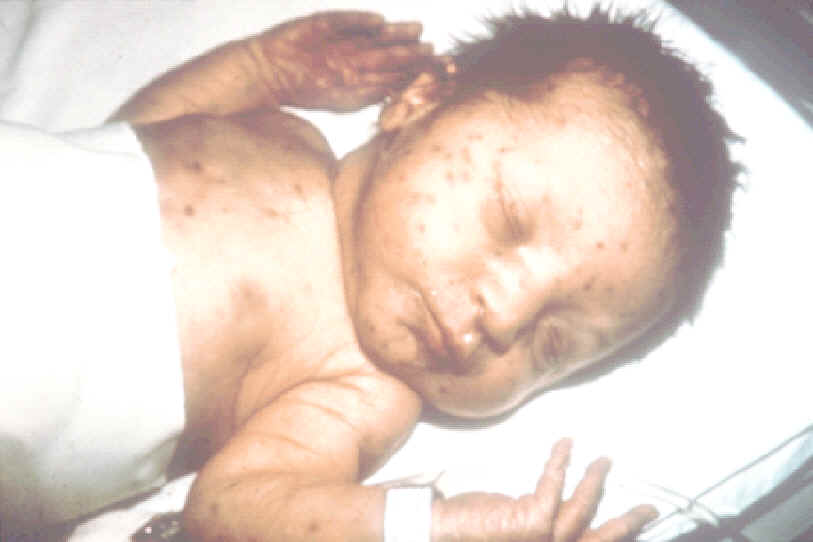 Rubella Virus
Rubella Virus 
Rubella virus has many properties which
are unique among the Togaviruses, which is the reasoning behind
its classification within its own genus: Rubivirinae. It
is the only Togavirus known to be transmitted via the respiratory
route, and the disease with which it is associated, Rubella or
"German Measles" was once ubiquitous in human populations.
Rubella virus can also act as a teratogen, inducing Congenital
Rubella Syndrome when spread from mother to fetus in the first
trimester of pregnancy.
Rubella in the Child and Adult:
- Incubation: 2-3 weeks
- Epidemiology: Rubella virus is spread
via respiratory transmission from human to human. Virus
is shed in oropharyngeal secretions and is highly transmissible.
In communities where vaccination is rare, spring outbreaks typically
occur every few years. In these communities, children represent
the largest number of cases, as adults usually acquire lifelong
immunity after the primary infection.
- Symptoms and Outcomes: The primary
symptom of Rubella virus infection is usually the appearance
of fine, pink macules on the face. This rash typically
spreads to the trunk and limbs and fades within 48 hours.
However, in up to 1/2 of all cases, no rash may be apparent.
Enlargement of postauricular, suboccipital, and posterior cervical
lymph nodes is also common. In adult females, mild polyarthritis
may occur. Rubella virus infection typically has no lasting
effect. Rare complications of Rubella virus infection include
thrombocytopenic purpura and postinfectious encephalopathy.
- Pathology and Pathogenesis: Rubella
virus enters via inhalation and infects cells of the respiratory
tract. It is then spread via the lymph nodes to the blood,
where it induces an immune response which leads to lasting immunity.
- Prevention and Management: The live,
attenuated Rubella virus vaccine is given universally to young
children in the US and many other developed countries.
It is given in two shots (at 15 months and 5 years) and produces
lasting immunity in more that 90% of recipients. Management
of Rubella virus infections is typically symptomatic.
Congenital
Rubella Syndrome: 
Congenital Rubella Syndrome
(CRS) is caused by infection of the fetus in utero during the
first trimester of pregnancy. This occurs only when the
mother acquires a primary Rubella infection during the first trimester.
20% of the children born after such an infection suffer the severe
congenital abnormalities associated with CRS. These include
neurosensory deafness, blindness, congenital heart disease, microcephaly
with mental retardation, growth retardation, and hepatosplenomegaly.
10-20% of these children die within the first year of life.
Due to the risk of CRS, unvaccinated women
should be immunized against Rubella at least 3 months prior to
conception.


Graphics obtained from MMWR vol.
46
Return to Togavirus
Home Page
 Rubella Virus
Rubella Virus 
 Rubella Virus
Rubella Virus 


